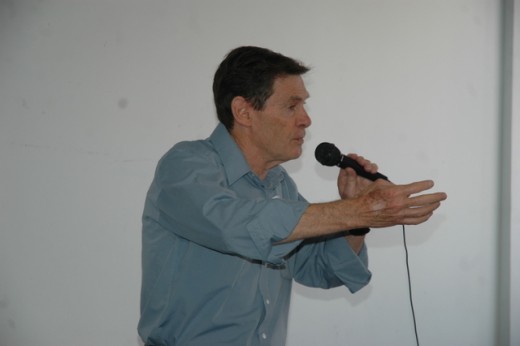Speaking Tips: Making Eye Contact and Public Speaking
Avoiding eye contact is a 'no-no' if you want to really connect

Avoiding looking your audience in the eye can cost you credibility
Speaking Tips : Effective contact and public speaking: things you need to know.
In public speaking we do not speak to an audience; we speak to individuals within an audience. Of course, we refer to these individuals - clustered together as they are - for conveniences sake, as ‘our audience.’ But the fact remains that each person is a separate entity as far as their attention to what we have to say is concerned. Some will – initially at least – volunteer their attention. These are our ideal listeners. Others will need to be drawn. And some others still, will have so-much on their minds that it will be difficult indeed to attract them, let alone have them hanging off every word.
The first key to public speaking is to consider the audience's desires
So with this knowledge in mind, how do we keep the audience attuned to our every word? Well, they’ve come to hear about something or other, be it information they want to learn; or to be it to entertained. Or maybe a bit of both.
The first key to public speaking is to consider the audience’s desires. It’s not about you. You’re only the message-bearer. Forget yourself. Easier said than done, I know, but this is what you need to do. Best way to do this is to be very comfortable with your material. Know it well. Equally important is the way you deliver your material. It is of equal importance – yes, equal importance! – to the material being presented.
A fundamental aspect of good delivery is eye-contact
One very fundamental aspect of good delivery is eye-contact . Every now and again you need to look an audience member, then perhaps a second, third and fourth, right in the eye. It needs to be more than a cursory glance. You need to meet their gaze and they meet yours. There has to be some kind of communication both ways . It might not last for more than a few seconds, but anything less and you’re not really seeing them. In public speaking, they don’t want a lecture. They want communication!
Speaking Tips: Take your time to take a good look

Each individual in the audience should feel you are speaking personally to him or her
Now, if you have a fairly small group, for example, if you’re standing at a table around which somewhat less than a dozen people are seated, then it becomes a relatively easy task to spend at least a few seconds – and maybe done a number of times – with each person in this way. But what happens when you’re audience numbers fifty, a hundred or two-hundred plus? How can you give each one of them individual attention? The answer is that you can’t. So you need to have a technique which appears to that audience that you are talking to each and every one of them individually.
How can this be done?
In making eye contact and public speaking you need to determine the optimum distance you'll be standing from your audience
It will, of course, depend much on the audience’s seating arrangements and your proximity to them. As a general rule, the smaller the audience, the closer you need to be. Likewise, with a really big audience, you can be at a greater distance. After a while, your intuition - based on body-language knowledge - will find you placing yourself at the optimum distance. You’ll know if you’re too far back.
Now, let us imagine that you’re out front of an audience of say, 80-100 people. The nearest person is ten feet in front of you, the furthest away, 120 feet or so. The room is full. They’re seated in rows, theatre style. You are standing before them, front and centre.
The how-to with a big audience
As said earlier, avoiding eye-contact is a "no-no." Okay, how do you make eye-contact? From where you’re standing you pick out two avenues or lines running off at an angle from you. The first might be forty-five degrees left. The second might be forty-five degrees right. The third will be someone near the front and centre. So, in effect, you let your eyes wander to three places. You then pick out a face in each of these three areas. If you can, you pick someone who looks friendly and interested in what you’re saying. Now you have system. Now you don’t have to attempt the impossible task of meeting the gaze of every single person.

After some practice, the technique will become natural to you.
You are, of course, not strictly limited to these three points. Very occasionally, you might scan right across to the left or the right, and even to the back row. But, by and large, you alternate your focus on those three points: someone four or five rows back at an angle of forty-five degrees or so to your left; someone perhaps the same distance back at forty-five degrees to the right. And someone perhaps fairly close at the front, in the centre.
If all of this sounds a little artificial you’ll find that, with a little practice, it won’t be. It will become natural to you.
Speaking Tips: In making eye contact be natural; don't be predictable
You need to avoid scanning the audience and meeting the eye’s of those you have picked out for eye-contact in a monotonous, regular routine. Don’t do that. Vary it! For example, you might go left, right, centre, right again, left, right again, centre. It has to be a natural unrepetitive approach or the audience will quickly pick up on it and start anticipating your rhythm. It’ll become off-putting.
And public speaking unites; the speaker becomes one with his audience
As I said, you will occasionally make eye contact with one or two right at the periphery of the audience. This will bring it home to them all, albeit at an almost subconscious way, that each and every one of them is included. And as you look forty-five degrees left at that person in, say, the fifth row, all of those along that line will think you’re talking specifically to them, even though you only meet the gaze of one person. The same, of course, would apply to the line running off to the right. And as you perhaps come forward, and address someone right at the front, you will be gaining that form of intimacy, of being close; “Close to one of us ” will be the thought.
In making eye contact, where and when do you look?
So, how much time do you spend in each sector overall?
Let us say that 40% is to the left, 40% to the right, 10% to the centre, and the remaining 10% to anywhere around the periphery of the audience. Such is a good and natural mix. By normal body movement, turning the heard slightly as required, all of this will come across very naturally.
Keep smiling,
Tom.
More on the writer
- Tom Ware - YouTube
Tom Ware is a Master Storyteller. Known as 'The Prince of Storytellers, Tom has been entertaining audiences with stories for thirty years. Tom joined his first Toastmaster Club in 1972. He's also been a member of Rostrum Clubs of NSW, the National Sp - Tom Ware Public Speaking The Prince of Storytellers
Tom Ware Public Speaking! Tips, events and videos to help you become a gifted speaker. Visit now!








